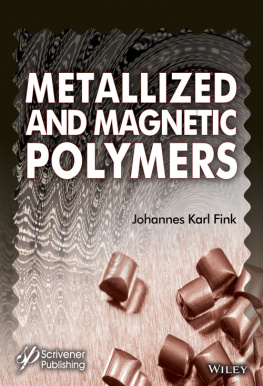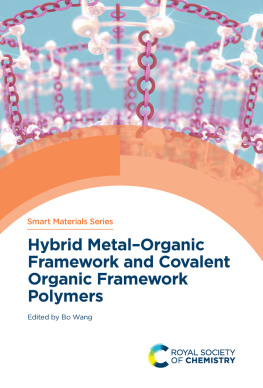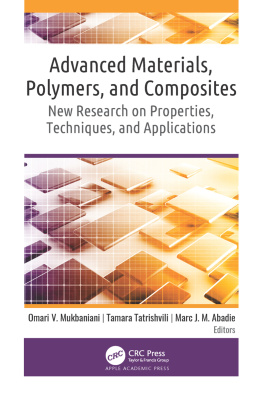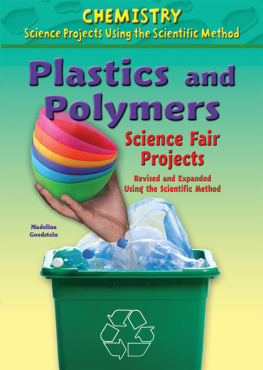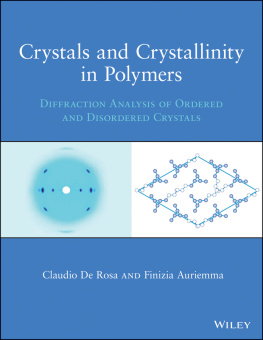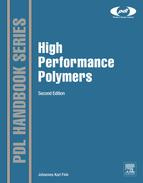Metallized and Magnetic Polymers
Scrivener Publishing
100 Cummings Center, Suite 541J
Beverly, MA 01915-6106
Publishers at Scrivener
Martin Scrivener ()
Phillip Carmical ()
Copyright 2016 by Scrivener Publishing LLC. All rights reserved.
Co-published by John Wiley & Sons, Inc. Hoboken, New Jersey, and Scrivener Publishing LLC, Salem, Massachusetts.
Published simultaneously in Canada.
No part of this publication may be reproduced, stored in a retrieval system, or transmitted in any form or by any means, electronic, mechanical, photocopying, recording, scanning, or otherwise, except as permitted under Section 107 or 108 of the 1976 United States Copyright Act, without either the prior written permission of the Publisher, or authorization through payment of the appropriate per-copy fee to the Copyright Clearance Center, Inc., 222 Rosewood Drive, Danvers, MA 01923, (978) 750-8400, fax (978) 750-4470, or on the web at www.copyright.com . Requests to the Publisher for permission should be addressed to the Permissions Department, John Wiley & Sons, Inc., 111 River Street, Hoboken, NJ 07030, (201) 748-6011, fax (201) 748-6008, or online at http://www.wiley.com/go/permission .
Limit of Liability/Disclaimer of Warranty: While the publisher and author have used their best efforts in preparing this book, they make no representations or warranties with respect to the accuracy or completeness of the contents of this book and specifically disclaim any implied warranties of merchantability or fitness for a particular purpose. No warranty may be created or extended by sales representatives or written sales materials. The advice and strategies contained herein may not be suitable for your situation. You should consult with a professional where appropriate. Neither the publisher nor author shall be liable for any loss of profit or any other commercial damages, including but not limited to special, incidental, consequential, or other damages.
For general information on our other products and services or for technical support, please contact our Customer Care Department within the United States at (800) 762-2974, outside the United States at (317) 572-3993 or fax (317) 572-4002.
Wiley also publishes its books in a variety of electronic formats. Some content that appears in print may not be available in electronic formats. For more information about Wiley products, visit our web site at www.wiley.com .
For more information about Scrivener products please visit www.scrivenerpublishing.com .
Library of Congress Cataloging-in-Publication Data:
ISBN 978-1-119-24232-1
Preface
This book focuses on the chemistry of metallized and magnetic polymers, as well as special applications of these materials.
After an introductory section on the general aspects of the field, the types and uses of these polymers are summarized, followed by an overview of some testing methods.
The text focuses on the literature of the past decade. Beyond education, this book may serve the needs of industry engineers and specialists who have only a passing knowledge of these issues, but need to know more.
How to Use this Book
Utmost care has been taken to present reliable data. Because of the vast variety of material presented here, however, the text cannot be complete in all aspects, and it is recommended that the reader study the original literature for more complete information.
The reader should be aware that mostly US patents have been cited where available, but not the corresponding equivalent patents of other countries. In particular, in this field of science, most of the original patents are of Japanese origin.
For this reason, the author cannot assume responsibility for the completeness, validity or consequences of the use of the material presented here. Every attempt has been made to identify trademarks; however, there were some that the author was unable to locate.
Index
There are three indices: an index of acronyms, an index of chemicals, and a general index. In the index of chemicals, compounds that occur extensively, e.g., acetone, are not included at every occurrence, but rather when they appear in an important context. When a compound is found in a figure, the entry is marked in boldface letters in the chemical index.
Acknowledgements
I am indebted to our university librarians, Dr. Christian Hasenhttl, Dr. Johann Delanoy, Franz Jurek, Margit Keshmiri, Dolores Knabl, Friedrich Scheer, Christian Slamenik, Renate Tschabuschnig, and Elisabeth Gro for their support in literature acquisition. In addition, many thanks to the head of my department, Professor Wolfgang Kern, for his interest and permission to prepare this text.
I also want to express my gratitude to all the scientists who have carefully published their results concerning the topics dealt with herein. This book could not have been otherwise compiled.
Last, but not least, I want to thank the publisher, Martin Scrivener, for his abiding interest and help in the preparation of the text. In addition, my thanks go to Jean Markovic, who made the final copyedit with utmost care.
Johannes Fink
Leoben, 2nd February 2016
PART I
METALLIZED POLYMERS
Chapter 1
General Aspects
There are monographs on the issues of metallized polymers (1). The topic of metallization of polymers has been reviewed (2).
Metallized plastic components have the same high-quality look and feel as chromium-plated metal parts and are less costly to produce (3). For these reasons, these materials are used in auto manufacturing for radiator grills or mirror caps, as well as for electronic appliances and bathroom fittings.
With a high-quality metallic coating, plastic components take on a luxurious chrome look. thus, they are popularly used in design elements for cars, electrical appliances, kitchens and bathrooms. In vehicles, radiator grills, mirror caps, door handles and trim are some items with such a finish. Push buttons and covers for hi-fi equipment, cell phones and coffee machines, as well as shower heads, are further examples of products coated with this method (3).
Plastic parts can be coated with metal, a process called metallization, for both aesthetic and mechanical purposes (4). Visually, a metal-coated piece of plastic features increased gloss and reflectivity. Other properties, such as abrasion resistance and electric conductivity, which are not innate characteristics of plastic, are often obtained through metallization. Metallized plastic components are used in similar applications as metal-plated parts, but tend to be lower in weight and have higher corrosion resistance, although not in all cases. In addition, electrical conductivity can be controlled in metallized plastic components, and they are inexpensive to manufacture. To metallize a piece of plastic, several common methods are used (4):
Vacuum metallization,
Arc spraying,
Flame spraying, and
Plating.
It is also possible to metallize a transfer film, and use alternative methods to apply the film to the surface of the substrate (4).
1.1 History
The history of fabrication of metallized polymers has been summarized (5, 6). The first commercial plating of polymers was done in 1905 (7). Also during World War II a fair amount of production took place. The large-scale production started in the mid-1950s (8). An electrical condenser with coated paper was described in 1910 (9).

